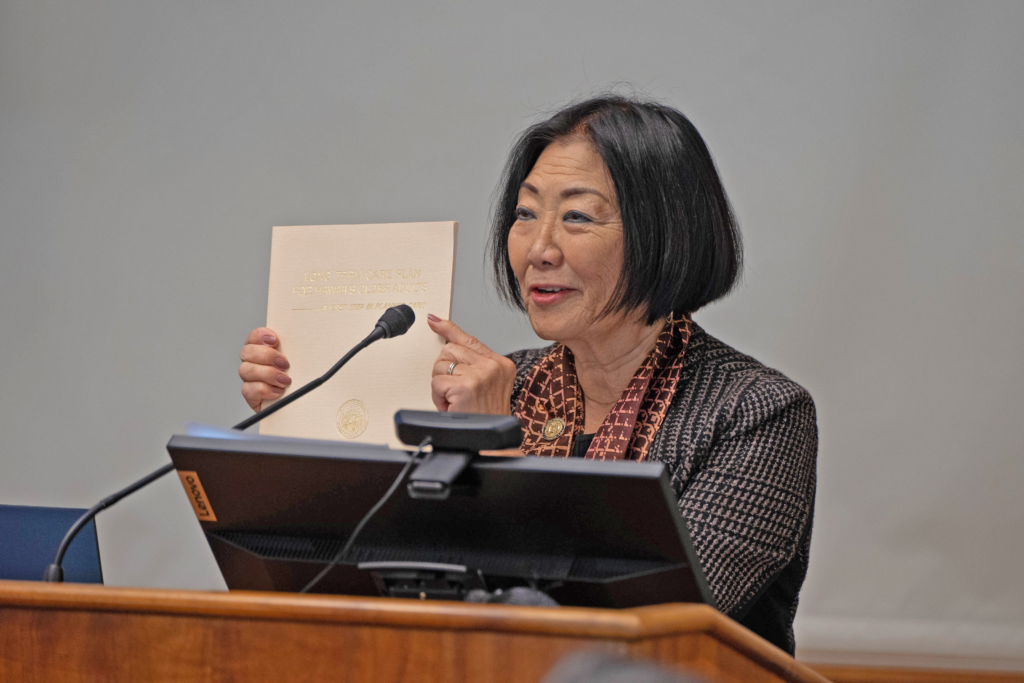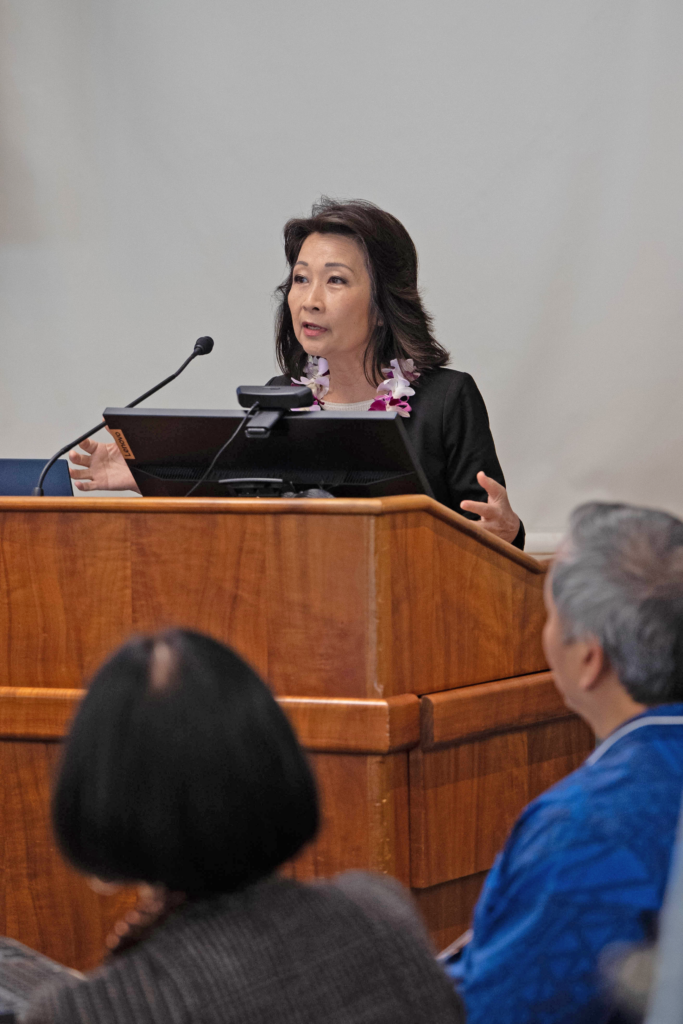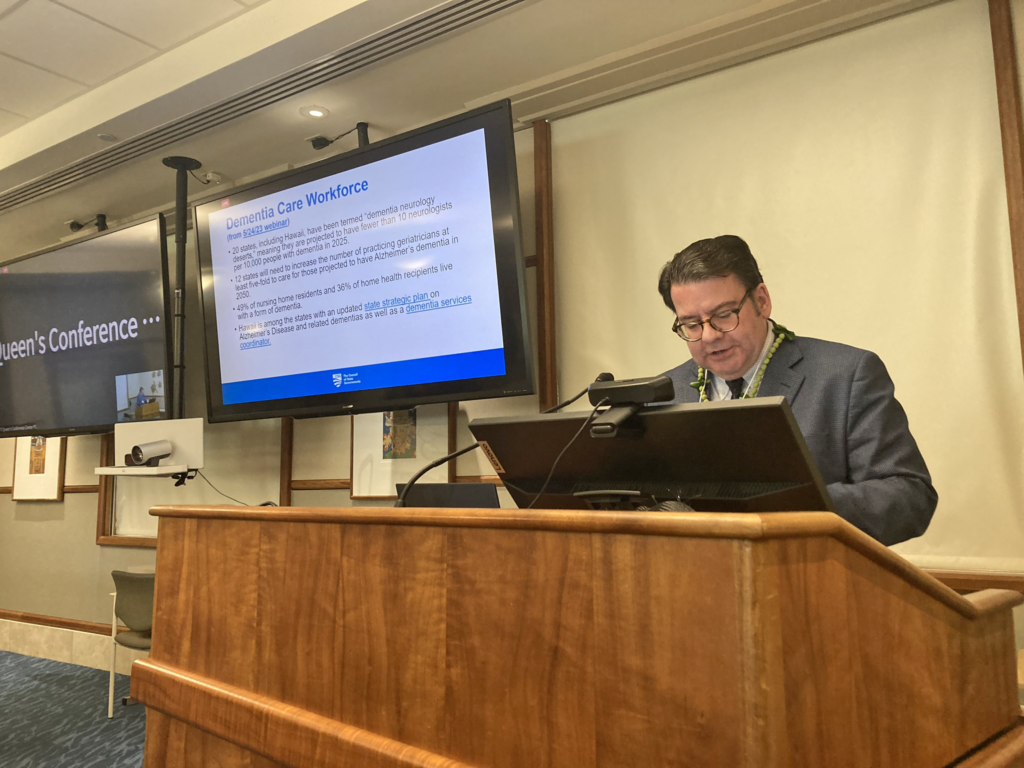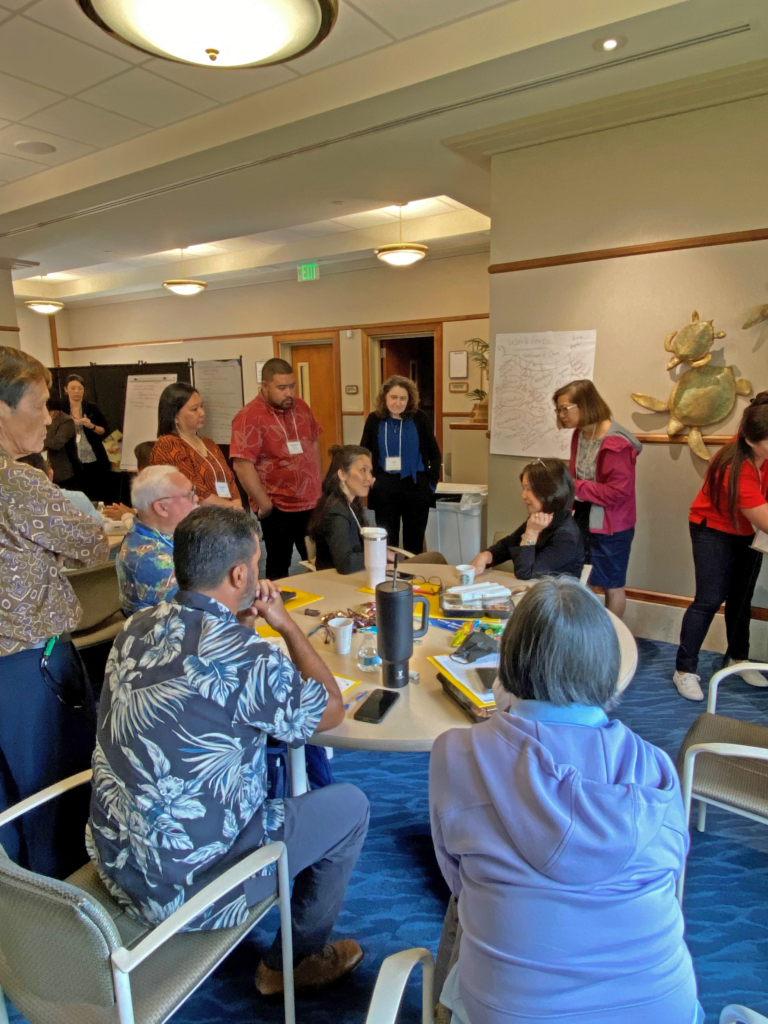By Sean Slone, Senior Policy Analyst

Photo credit: Charles Izumoto, Office of Hawaii Sen. Sharon Moriwaki.
Brandishing a document of some historical significance, Hawaii Sen. Sharon Moriwaki opened a day-long summit on Hawaii’s long-term care system at the Queen’s Medical Center in Honolulu on Feb. 28. The document Moriwaki possessed was a copy of a report titled “The Long-Term Care Plan for Hawaii’s Older Adults: A First Step in Balanced Care.” It was dated July 1988.
“Hawaii started the journey some 35 years ago,” said Moriwaki to the gathering of more than 50 state policymakers and stakeholders. She noted that the report addresses many of the topics she and her colleagues are still concerned with today: person-centered care, supports for informal caregivers, government coordination and finance mechanisms.
“The care for our Kupuna [the Hawaiian word for ‘honored elder’] is substandard. It doesn’t have the type of attention and funding that is needed when you compare it to all the significant services in our state.”
— Hawaii Lt. Gov. Sylvia Luke, a former state legislator and long-time chair of the House Finance Committee
Photo credit: Charles Izumoto, Office of Hawaii Sen. Sharon Moriwaki.

Moriwaki, Luke and their fellow policymakers kicked off the next part of Hawaii’s policy journey by inviting The Council of State Governments and policymakers from California, Minnesota and Washington to provide details of successful policy strategies being deployed around the country, not only financially, but also in building the long-term care workforce of tomorrow and creating a system of long-term care that can be more responsive and sustainable.
Hawaii was one of eight states that participated in a 2022 task force convened by CSG with support from The Commonwealth Fund. The task force guided the development of the CSG Long-Term Care Policy Guide, which was published in early 2023. The guide, which is now reflected on the CSG Long-Term Care Workforce Policy website, identified seven state strategies to revitalize the long-term care workforce, including:
- Increasing compensation.
- Providing employment supports.
- Enhancing training and education.
- Facilitating career advancement.
- Expanding the pipeline.
- Investing in data collection and monitoring.
- Supporting family caregivers
Photo: CSG Senior Policy Analyst Sean Slone shares strategies from the CSG Long-Term Care Policy Guide with attendees of the long-term care summit at the Queen’s Medical Center in Honolulu on Feb. 28. Photo credit: Charles Izumoto, Office of Hawaii Sen. Sharon Moriwaki.

As part of the February summit, CSG shared numerous policy examples in each of those state strategy categories.
Attendees also had the opportunity to hear from Bea Rector, assistant secretary for aging and long-term support at the Washington Department of Social and Health Services. Rector said her state focused on supporting the choices of Washingtonians who want to receive long-term care in a preferred setting, which often means in their homes and communities, rather than in institutional settings such as nursing homes.
“In Washington, we’re creating cost-effective, preferred community providers and settings as alternatives to nursing homes. In the early ’90s, almost 50% of the people who received services under Medicaid were served in skilled nursing facilities. Today, it’s 9% and still shrinking, which means 91% of individuals are receiving services in their own homes or in their communities.”
— Bea Rector, assistant secretary for aging and long-term support at the Washington Department of Social and Health Services
Rector said the state moves about 950 Medicaid-funded nursing home residents out of facilities every quarter. That rebalancing effort saved the state and federal budgets nearly $5 billion over the past 20 years.
Washington is also known for a first-in-the-nation social insurance model that allows working Washingtonians to contribute toward expensive long-term care over time and avoid incurring the medical debt many American’s face.
“You have to impoverish yourself to actually get Medicaid eligibility and get the services that you may desperately need,” Rector said. “Our Legislature decided that, as a state, we needed a better support system for caregivers and for the people who need care with a more innovative financing mechanism and ways of delivering the care that’s needed.”
Passed by lawmakers in 2019, and now known as the WA Cares Fund, the social insurance program since last year has required Washingtonians to contribute a small percentage of their income to pay for long-term care insurance. Benefits from the program will become available for qualified individuals in 2026. The program is expected to yield a $36,500 lifetime maximum benefit for retirees.
Interestingly, the WA Cares Fund model took inspiration from something passed by the Hawaii Legislature in 2002 but was ultimately vetoed by former Gov. Linda Lingle.
“So now we get to take inspiration from them,” said Judy Mohr Peterson, administrator for the Med-QUEST Division, Hawaii’s Medicaid agency. “If we really want to build families up, we have to think differently about how it is that we fund and pay for long-term care and not rely on the Medicaid program to do it all.”
Summit attendees also got the chance to hear how Minnesota achieved a number one ranking among the states in AARP’s 2023 Long-term Services and Supports State Scorecard for older adults, people with physical disabilities and family caregivers.
Natasha Merz, assistant commissioner for aging and disability services at the Minnesota Department of Human Services, said the ranking can be attributed to the state’s efforts to provide support for family caregivers and to provide many options for long-term care settings. In recent years, the state has made critical investments in home and community-based services thanks in part to the American Rescue Plan Act. Minnesota’s Legislature has shown a willingness to invest in Medicaid reimbursement rates as well.
“As proud as we are of this recognition from AARP,” Merz said, “we also know that we continue to have work to do, particularly towards reducing disparities in access to supports for underserved communities, communities of color, culturally specific services and other inequities.”
Many of the strengths Minnesota was praised for in the AARP Scorecard Merz credits to being areas of focus in the state’s multi-sector master plan for aging, known as Age Friendly Minnesota. A master plan for aging, as explored by several states in recent years, is a cross-sector strategic planning process that can help states better coordinate long-term services and supports.
California is another state that is no stranger to this process. Since taking office in 2019, Gov. Gavin Newsom made establishing a master plan for aging a priority. The state’s plan, California for All Ages, officially launched in 2021.
“I think that there was some skepticism initially that this would just be another academic exercise that could really not lead to a lot of change. It’s critical to have leadership driving this from the governor’s office, a cross-agency partnership to address the range of issues that impact older adults, people with disabilities and caregivers. It’s also important as part of that to have legislative leadership invest in and oversee the programs and services that are needed across the system to meet the goals of our master plan for aging.”
— Sarah Steenhausen, deputy director of policy, research and equity at the California Department of Aging
Steenhausen suggested other keys to developing a successful master plan, including meaningful stakeholder engagement, data-driven policies and accountability. She said California is addressing long-term care system change in the context of its master plan by focusing on four areas:
- Navigation — Creating the framework for a no-wrong-door system in which people can access the information they need to make informed decisions.
- Financing — Addressing long-term services and supports financing and affordability including considering a public benefit similar to Washington’s WA Cares Fund.
- Access to programs and services — Embarking on a gap analysis of the state’s home and community-based services.
- Workforce — Developing training, stipends and incentives for direct care workers and addressing wages and benefits.
Photo: Hawaii policymakers and stakeholders participate in breakout group discussions during the long-term care summit at the Queen’s Medical Center in Honolulu on Feb. 28.
Photo credit: Sean Slone.
The Hawaii Long-Term Care Policy Agenda
Hawaii policymakers are seeking the guidance of Minnesota, Washington, California and other states as they try to move forward with an ambitious long-term care policy agenda of their own this year. The package of bills under consideration include:

- HB 2224, which would require the Executive Office on Aging to create a comprehensive long-term care master plan.
- SB 3383, which would authorize a statewide assessment of the needs of the long-term care workforce and home and community-based services providers.
- HB 1827, which would appropriate funding to support health care workforce development programs, including a public high school certificate program and an employment pathway for certified nurse aides.
- SB 849, HB 2216 and HB 1974, which would amend the state supplemental payment ceiling for adult residential care homes, licensed developmental disabilities domiciliary homes, community care foster family homes, and certified adult foster homes and increase the monthly needs allowance for residents from $50 to $75.
- HB 2215, which would increase funding of certain Medicaid home and community-based services, including adult day programs, community care foster family homes and expanded adult residential care homes.
- SB 2473 and HB 1769, which would establish a refundable Family Caregiver Tax Credit for nonpaid family caregivers.
- SB 2285, which would beef up the functions and duties of the State Health Planning and Development Agency.
The Hawaii policymakers and stakeholders who gathered in February also recognize that some of the pricier components of a comprehensive long-term care reinvention may require waiting for a future legislative session, especially as the Aloha State focuses this year on the significant fiscal commitment required to rebuild Lahaina, the Maui community devastated by fires in 2023.

One of the purposes of the February summit though was to empower local champions and allow them to demonstrate a commitment to continuing the push toward policy change in long-term care that, for Hawaii, began over 30 years ago. At a follow up briefing the day after the summit, attendees were asked to add their name and organization to paper flowers pinned to a diagram of a Hawaiian lei. Policymakers hope those commitments, both in practice and symbolism, can demonstrate the urgency many in Hawaii feel about addressing these issues in a timely way.
Photo: Participants at Hawaii’s long-term care summit added their names and organizations to a symbolic commitment lei during a follow up briefing on Feb. 29 at the Queen’s Medical Center in Honolulu on Feb. 28. Photo credit: Sean Slone.
Notes: As part of its ongoing long-term care workforce policy work with The Commonwealth Fund, CSG provides technical assistance to states on strategies to revitalize the long-term care workforce. The Hawaii summit, which can be viewed in its entirety on YouTube, was one example of a CSG technical assistance state visit. Earlier in February, CSG Senior Policy Analyst Sean Slone also spoke about state strategies before a hearing of the Illinois House Human Services Committee. To request more information about state visits for technical assistance or testimony on these issues, contact Sean Slone via email at [email protected].
Multi-sector master plans for aging will be the focus of the next meeting of the CSG Long-Term Care Workforce Network, which will take place March 18 at 3 p.m. ET. Since 2022, the Center for Health Care Strategies (CHCS) has been offering guidance to states as part of master plans for aging learning collaboratives. On this hour-long webinar, Carrie Graham, Ph.D., director of aging and disability policy at CHCS, will discuss the collaboratives. Kevin Hancock, who has led the MPA process in Pennsylvania and Rob Ence, who has been a part of the process in Utah, will also join the conversation. Register here now to receive the Zoom link for the webinar: https://csg-org.zoom.us/webinar/register/WN_dV6E2RITSAWniHl-xYq4TQ#/registration. All are welcome to participate.




